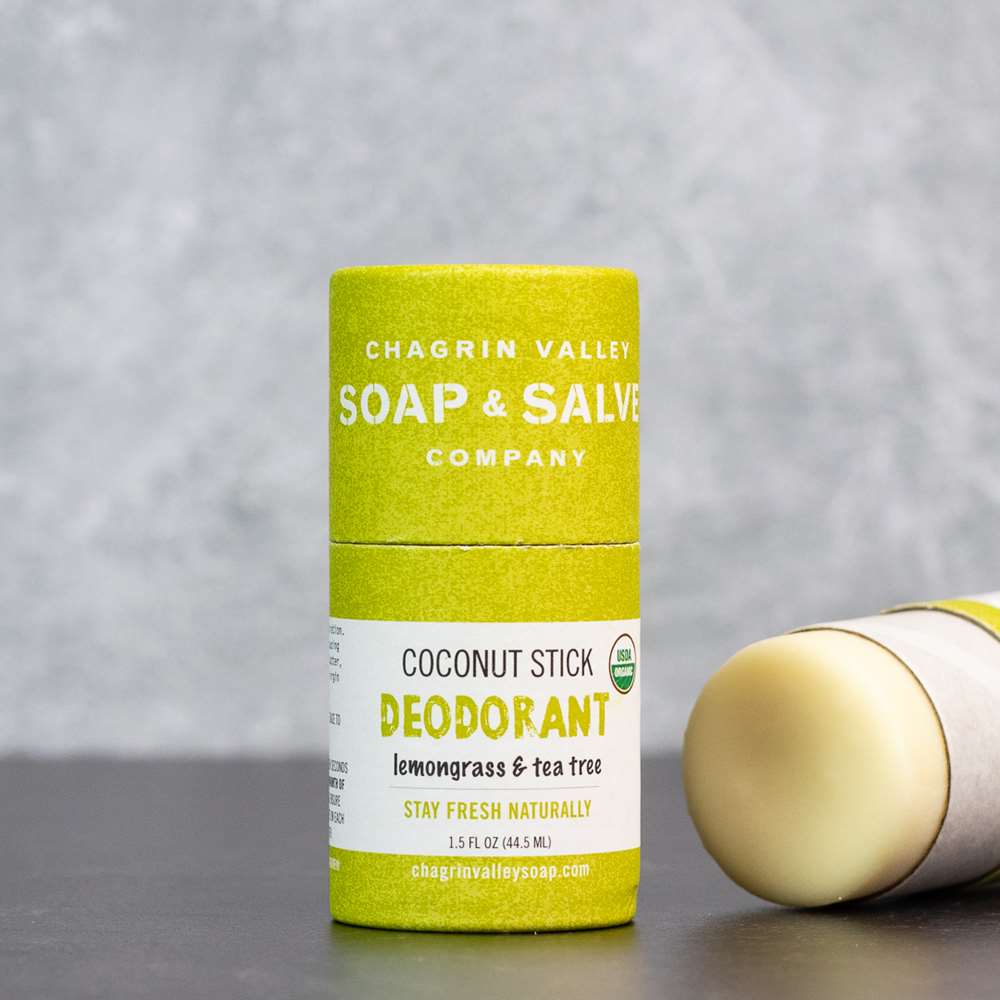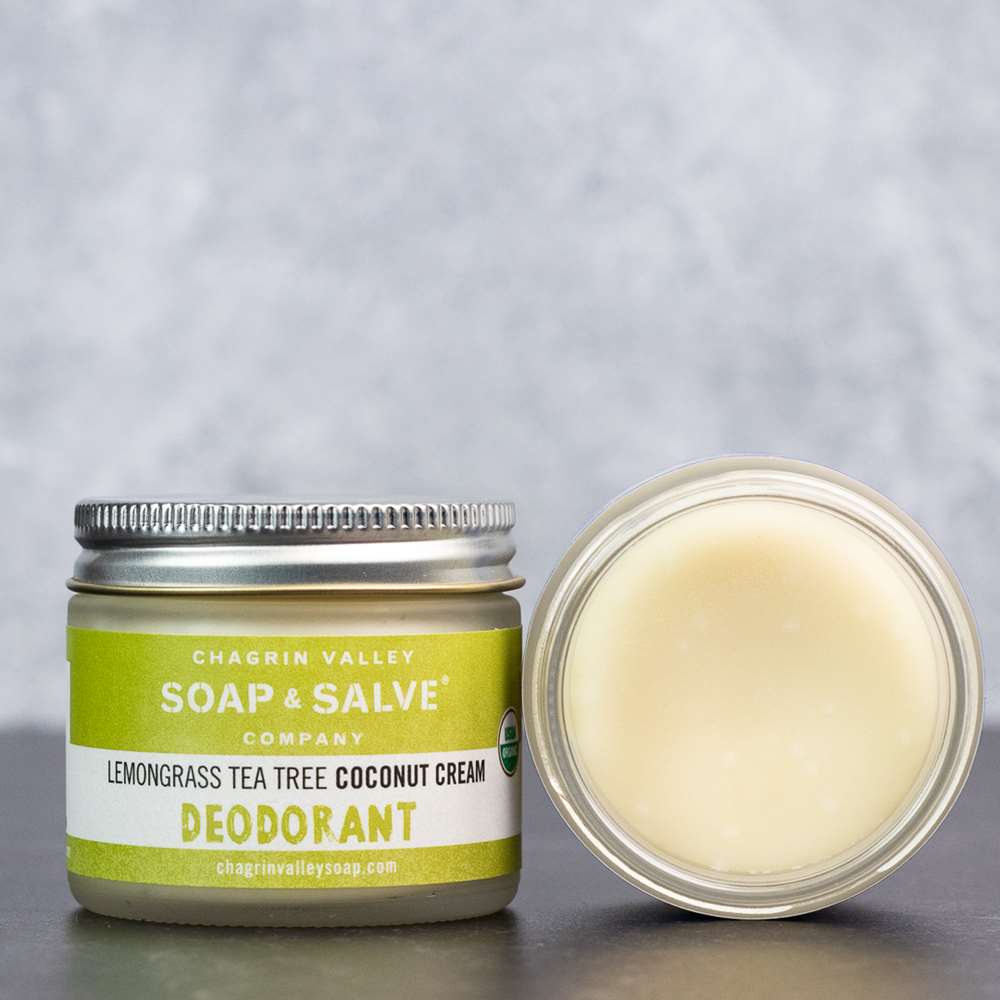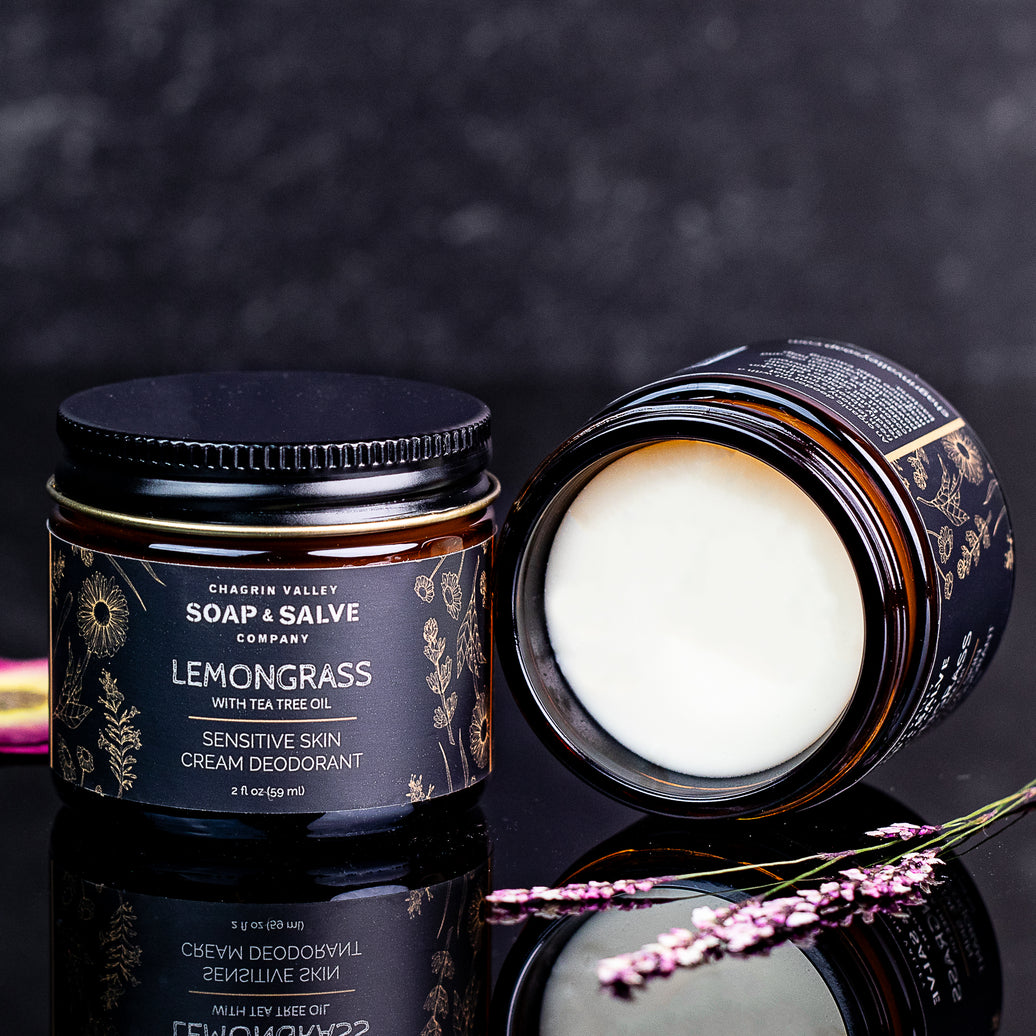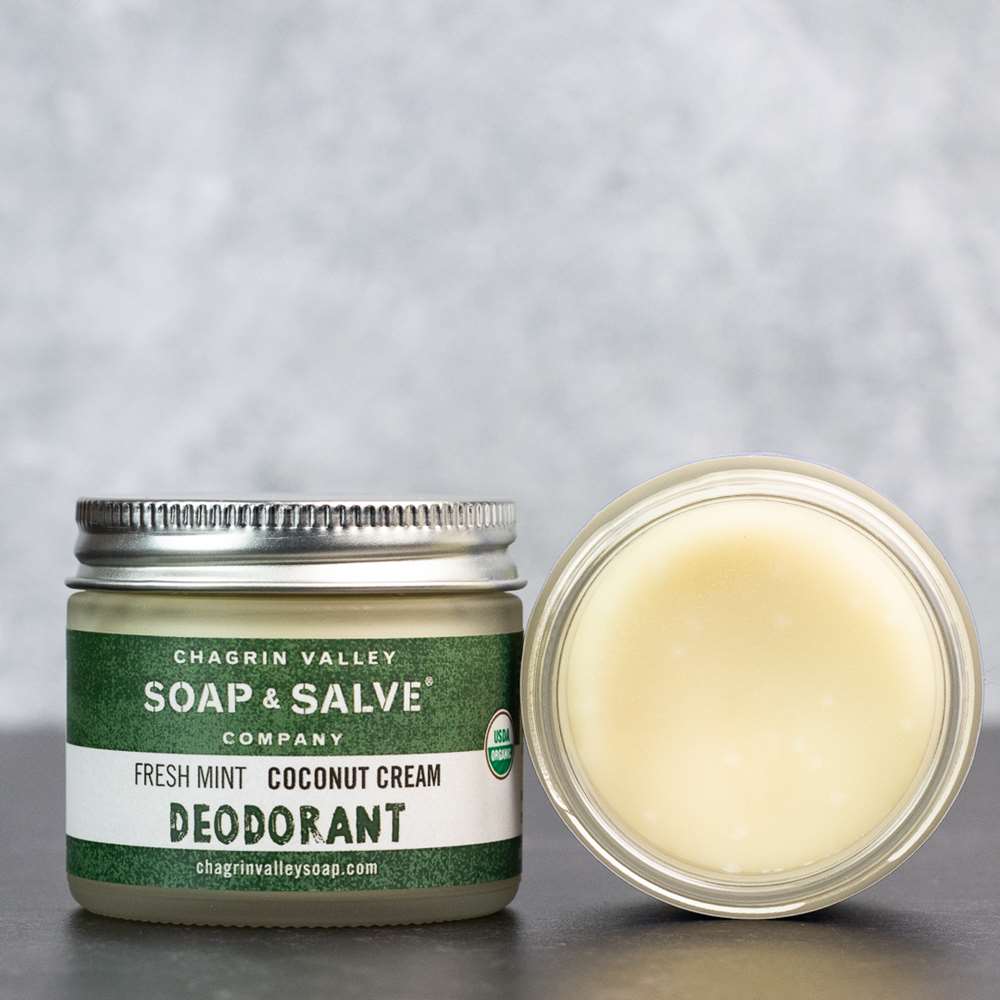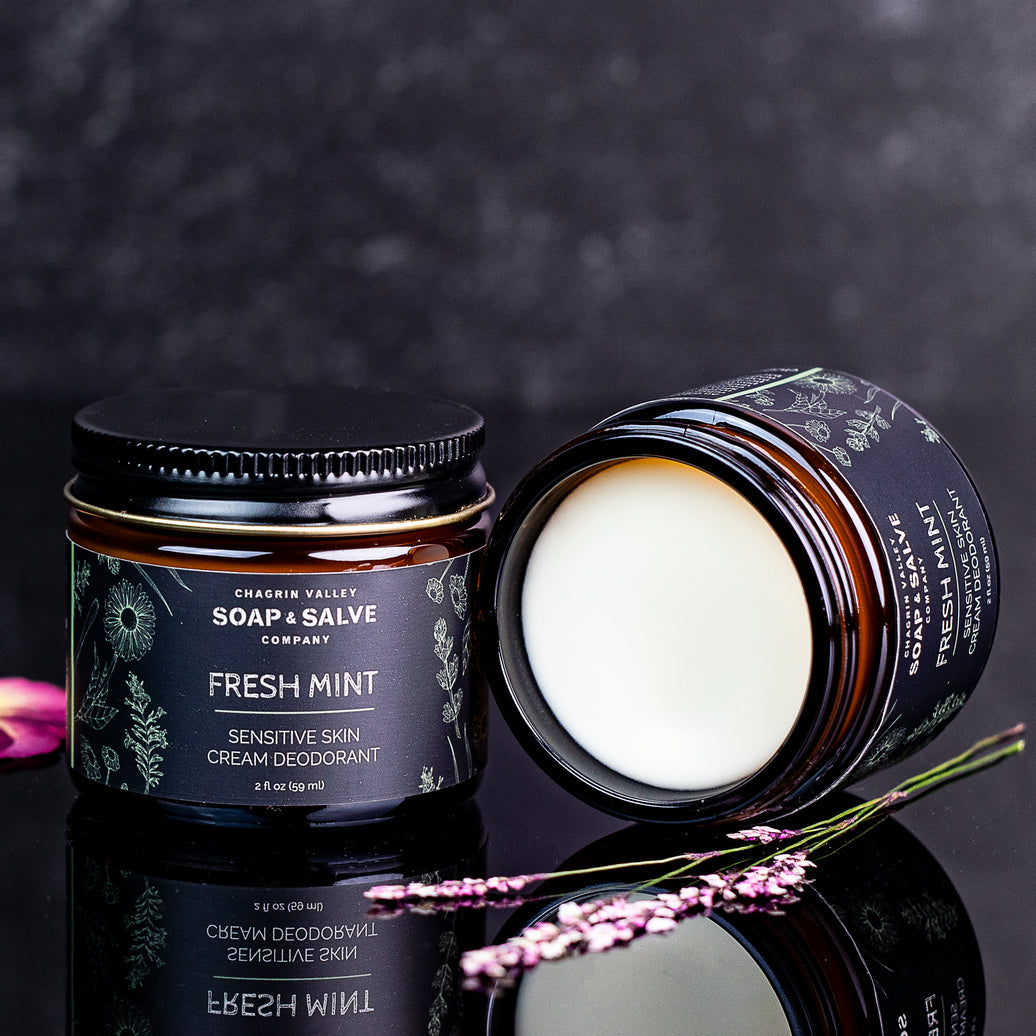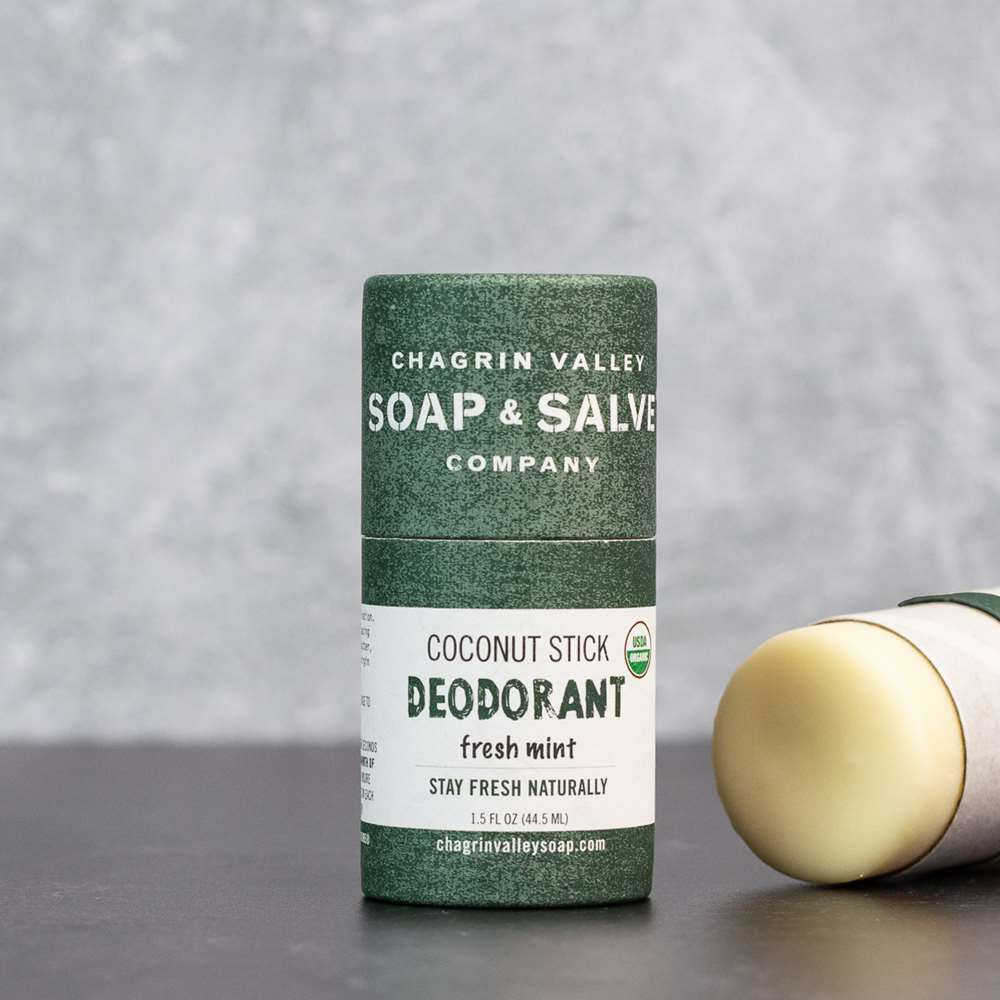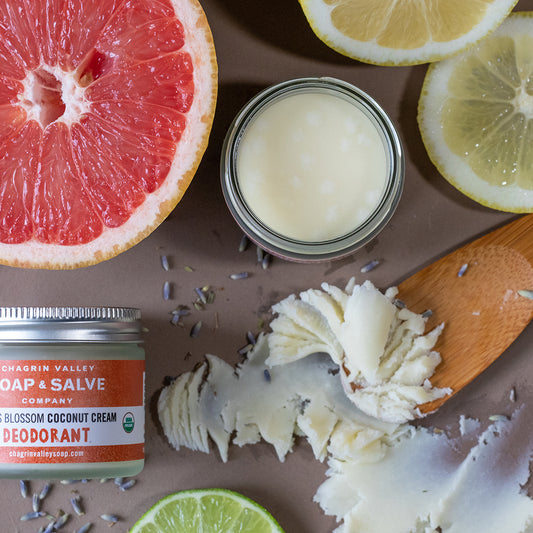Transitioning to Natural Deodorant: Part 2
Many people transition seamlessly to a natural deodorant while others report an adjustment period. For that reason, some people who support a more "natural" lifestyle have trouble giving up their conventional deodorant or antiperspirant, even though they really want to make the change to plant-based ingredients.
Part 1 of this blog discussed the changes that occur in your armpits when you stop using conventional deodorants or antiperspirants as well as the possible causes of irritation that some may experience when switching to an all-natural deodorant.
 Part 2 provides some suggestions to help with the changes you may experience as you transition to natural deodorant.
Part 2 provides some suggestions to help with the changes you may experience as you transition to natural deodorant.
Switching to a natural deodorant may require a little work and patience for some, but in the end, when you find a natural deodorant that works for you and that you feel good about using, the journey will be worth it.
First Steps to Natural Deodorant
Obviously, you need to stop using your old antiperspirant or deodorant.
We have found that going au naturale, without any deodorant, for at least a few days (longer would be even better) before switching is very helpful.
If possible, start your transition during cooler weather and begin over the weekend or a time when you will not be as concerned about odor.
You do NOT need to buy armpit "detox" kits. Making or purchasing these kits, using clay masks, vinegar or special exfoliating scrubs will not speed up the transition by drawing "toxins" from your body.
-
Vinegar: While I agree that vinegar may help remove some odor, so will soap and water. And if you have an irritation the vinegar can really sting!!!
- Exfoliating Scrubs: Exfoliating your armpits will help remove excess dead skin and bacteria trapped in the armpit area. However, if you clean your armpits by rubbing them with a soapy washcloth, they are already being exfoliated.
Furthermore, any new product added to your armpit area--including clays, scrubs, vinegar, etc. can alter the types and amounts of bacteria and prolong the re-balancing period.
The only "detoxing" you need is taking a break from using antiperspirants and synthetic deodorants.
Increase Sweat Production
If you find you are sweating more . . . that is a good thing. Antiperspirants block pores and trap the sweat, which is really not what you want. Natural deodorants allow your underarms do what they were designed to do--sweat.
The bottom line--when you get hot you are going to sweat. Also, when you get nervous or anxious you are going to sweat--and stress sweat smells worse than regular sweat.
 Give it a week or two and the increased perspiration will balance out. But this temporary increase may lead to sweat chafing or other skin irritations.
Give it a week or two and the increased perspiration will balance out. But this temporary increase may lead to sweat chafing or other skin irritations.
Some Things To Help:
- Keep the skin folds as dry as possible
-
Powder: Apply a light coat of organic talc-free, cornstarch-free botanical starch body powder
- Although a powder will not keep you from sweating, it will absorb wetness to help reduce friction and irritation.
- Organic arrowroot powder or tapioca flour can work or try our Organic Body Powders to help absorb excess moisture. They are also great as a light deodorizing alternative to any deodorant.
-
Clothing: Fabrics made from natural fibers like cotton, linen, wool, bamboo, and hemp fabrics are much better at wicking away moisture than synthetic clothes
- Do not wear tight-fitting clothes, loose-fitting sleeves will allow the underarm area to breathe
- When possible wear something sleeveless to allow the area to get some fresh air
Transitional Increase Odor
As I discussed in Part 1 of this blog you may experience a temporary increase or change in underarm odor as the armpit bacterial populations begin to change.
Some suggestions:
- Keep armpits dry to help prevent bacterial growth
- Washing: Lather up with a good natural soap and wash your underarms thoroughly with a washcloth or body sponge to remove dead skin, trapped sweat, and bacteria that contribute to body odor (especially during summer, after a workout, or a very stressful day)
- Hydration: Drink plenty of water which has the effect of watering down and diluting your sweat to help decrease the odor
- Clothing: Fabrics made from natural fibers like cotton, wool, bamboo, and hemp fabrics hold in less odor and wash out better than synthetics
-
Diet: Some foods can actually increase body odor so change up your diet temporarily. According to Berkeley Wellness of the University of California, some of these foods include broccoli, cabbage, cauliflower, onions, garlic, red meat, fatty foods, and alcohol. (Source)
- a whole-food, plant-based diet is good for you--but at least temporarily try adding more green leafy vegetables, high fiber foods and healthy fats like nuts
With a natural deodorant, especially during the transition time, you may need to reapply during the day.
Deodorant Application
Often times the biggest obstacle to success with a natural deodorant, is the way in which it is applied.
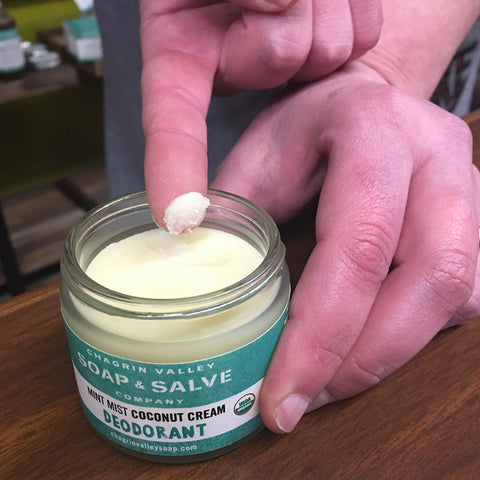 The best advice I can give is to apply only a small amount of deodorant. Most people apply to too much!
The best advice I can give is to apply only a small amount of deodorant. Most people apply to too much!
To be perfectly transparent, I am a cream deodorant person and I like to apply my deodorant with my fingers. While I realize that using your fingers to apply deodorant may seem strange, I just want to take a moment to share my rationale.
By using your fingers is it easier to control the amount of product going on at each application. It is easier to give the entire underarm area a uniform coat of product without using too much. Basically, you can tailor the application to your personal needs.
I discovered early on that I can easily control underarm odor (even during Zumba class) and prevent irritation by using only a small amount of deodorant.
NOTE: Our natural deodorants are made from plant oils and butters. Since water and oil do not mix, it is best to always apply to dry underarms otherwise the deodorant may not absorb into to your skin and can end up on your clothes.
My technique is a simple one.
- I scoop out a pea-sized amount of deodorant with my clean index finger on my right hand--I am righthanded.
- Then I rub the deodorant between the two fingers on my right hand and the same two fingers on my left hand.
- I use these fingers to apply the deodorant to clean and dry skin.
- The deodorant softens from the warmth of my fingers and helps create a smoother more uniform application.
- I gently massage the cream deodorant into my skin until it is no longer visible. For me, the pea-sized amount is enough for both arms.
The intimate nature of applying deodorant allows you to become more comfortable with your own body and to get to know your body better. This is really important for both men and women. Try it! Once you get into the habit of using your own fingers you may never go back to a stick deodorant or an applicator.
OK . . . I'll get off my soapbox!
If you do not want to use your fingers, follow the same procedure using the back of a small spoon or spatula. Since the armpit is concave and not flat, the back of a bowl-shaped spatula works so much better than a flat applicator.
When applying our NATURAL STICK DEODORANT, push a very small amount of product up, just a bit beyond the cardboard container. Since the sticks are by nature a harder formulation it is important to place the deodorant on your armpit for a few seconds to warm and soften the deodorant which again helps create a smoother more uniform application, especially if you have underarm hair.

Then gently dab or swipe the deodorant across the armpit. Do not rub or drag the stick--gentle is the key! Try just a couple of swipes for starters.
When you make the change from something that you have been doing for a long time you may find the new routine awkward.
Some things to keep in mind:
- Natural deodorants may feel stiff right out of the jar or stick (especially in winter)
- Do not rub vigorously or drag the deodorant across the armpit when applying . . . Since baking soda has a bit of grit to it, a harsh application may cause irritation
- Our organic deodorant is best applied when the underarms are clean and the body is warm and dry
- If your armpits are damp -- as they are after you towel off from a shower -- the deodorant may not adhere to the skin
- If your armpits are damp, the natural oils in the deodorant can trap water next to the skin which can cause irritation
- Our formulas will soften upon contact with body heat. Allow the natural warmth of your body to soften the deodorant for a smoother more even application*
- Be patient
- Warming will allow the natural ingredients to absorb more completely so you get the best protection
- Warming helps prevent rubbing friction that may lead to irritation in the delicate underarm area
- The Amount: Natural deodorants do not need to be slathered on like conventional deodorants
-
A little goes a long way
- If you are using the same amount of natural deodorant as your old conventional brand, then you are probably using way too much
- If you give the deodorant time to soften against your skin before applying it is much easier to apply a THIN coat!
- Use a lot less than you think you need--you can always use more tomorrow!
- Using too much natural deodorant, especially one that contains baking soda, will increase the chance of irritation
- Using too much deodorant may also cause residue on your clothes
- Less is more is definitely the case with our deodorants
*The consistency and texture of a Natural Deodorant will change seasonally with changes in temperature. The deodorants will naturally be softer and easier to apply in warmer temperatures.
In colder weather, you may need to warm the deodorant against your skin a bit longer in order to allow your body temperature to soften it.
Whichever type of deodorant you choose . . . be patient, warm first, and then gently glide. Be sure to apply a thin, smooth even coating evenly across the entire armpit.
Shaving Irritation
The human armpit presents many challenges to shaving. The skin is very delicate, razors do not comfortably fit their cave-like shape, and their location makes it difficult to see what you are doing.
Create your own personal technique to help minimize shaving irritation. Here are some suggestions:
- always use a fresh, clean razor
- never shave with a dull blade
- dull old razors can harbor bacteria
- use a bar of moisturizing, natural soap, or oil to add slip to the razor
- apply lightweight moisturizer after shaving
No matter how carefully you shave, razors cause microscopic tears in the delicate armpit skin. As a result, applying deodorant directly after shaving can be irritating, even when using a natural deodorant.
While many deodorant websites will tell you to wait 10 to 30 minutes, we suggest shaving at night and applying deodorant in the morning. Allowing your underarms to rest, repair, and heal overnight can help prevent irritation.
Baking Soda in Natural Deodorant
 While many people use baking soda deodorants without problems, some people are extra sensitive to baking soda in the armpit area--I discussed the "why" in Part 1 of this blog.
While many people use baking soda deodorants without problems, some people are extra sensitive to baking soda in the armpit area--I discussed the "why" in Part 1 of this blog.
So, why do we use baking soda in some of our deodorants? Because it just works so well to eliminate odor for those who really need it.
As we experimented for months and months with our natural deodorant formulations, there was one consistent factor, baking soda tends to perform better at fighting odors than other ingredients found in natural deodorants.
For some, the irritation only occurs during the increased sweating period of transition. For some, the armpits just need some time to adjust to the baking soda. For others, there is simply a sensitivity to any amount of baking soda.
Above I suggested going without any deodorant for a few days--or as long as possible. As the microbiome in your armpit changes and sweat production increases, there may also be temporary changes in the pH of your sweat.
Wait a bit before starting a baking soda deodorant. If you immediately begin using a natural deodorant that contains baking soda and develop an irritation, you will not know if it is truly a long-term sensitivity or just a sensitivity due to changes in the microclimate of the armpit during the adjustment period.
If you are concerned about a baking soda sensitivity or have already experienced an irritation when first switching deodorants try one of our baking soda-free Sensitive Skin Deodorants. They are made with magnesium hydroxide instead of baking soda.
Learn More: Magnesium Hydroxide vs Baking Soda
If you are past the natural adjustment period, still experiencing irritation, you love or need a baking soda deodorants, and you believe the issue is due to baking soda--here are some suggestions from our staff and our customers:
- Apply deodorant to clean skin
- Wash armpits before application with a mild soap that cleans without stripping the skin of natural oils
- Be sure that the armpit area is dry before application otherwise wetness can get trapped under the emollient ingredients and cause irritation
- Wash armpits before bed so that the skin is clean and the baking soda is not sitting on the skin all night
- Very important--allow the deodorant to warm up before applying to reduce friction
- Try dabbing instead of swiping again to reduce friction
- Do not over apply: Using too much is one of the main causes of a baking soda reaction. Do not apply more than a couple of swipes per pit at a time
- Keep your tender underarm skin well-moisturized
- Some people have found that very light moisturizing after shaving, before bed, or after showering prevents dryness, reduces friction rubbing, and helps maintain healthy underarms
- Moisturizing a few minutes before applying deodorant helps reduce friction and creates a bit of a barrier
- You do not need to purchase some special pre-deodorant product. A very, very tiny amount of organic virgin coconut oil or your favorite light organic massage oil will do. One customer used her facial oil, another suggested sunflower oil, and another used our calendula salve. I personally believe the lighter the product the better. You do not want to create a sticky gooey mess before you even apply deodorant--that simply sets you up for irritation
- Stay away from lotions (which are mainly water) or moisturizers with fragrance oils or other synthetic ingredients
- If you experience irritation give your armpits a few days to rest
- Consider alternating by using a baking soda-free deodorant, like our Sensitive Skin Deodorants, every other day
I like the baking soda deodorants best and use them all the time. I don’t usually have any problems with irritation. But once in a while (don’t know why) I get some itchiness. What I do is use something before my deodorant to be a kind of barrier. I often use whatever I have around. I have used coconut oil, your lip balm, the coconut lotion bar and other stuff as long as it is VERY light just about any natural moisturizer will do. I found that thick creams make it worse. After a day or two my skin is back to normal with no itch and no irritation.--Melissa, New York
Customer Tip
Vinegar? A few months ago a customer shared her "hint for success" with baking soda deodorants. She explained that years ago a jeweler told her that her skin was reacting with some of her jewelry because her sweat was acidic.
So she was not surprised when she developed an irritation from our baking soda cream deodorant.
She now uses a dilute apple cider mixture before applying the deodorant to help neutralize the baking soda. To be honest this really did not make sense to me. She has acid sweat and is adding more acid to the armpit environment.
But she believes that the vinegar mixture somehow tones down the baking soda. Whatever chemistry is going on here--it works for her. She uses this method every day and went from constant irritation to none. I have not tried this and do not know how effective it will be, but she swears by it.
Here is her recipe.
- mix 1/2 to 1 tablespoon of raw apple cider vinegar with 1 cup of water in a clean spray bottle (or any container)
- shake well and after showering or washing, spray or dab a small amount of the dilute vinegar mixture on the armpit area and gently massage
- allow the area to dry completely (she emphasized it really must be completely dry) and then apply the deodorant
- do NOT use if you have just shaved--it will sting
- do NOT use if your armpits are irritated wait until they have healed or it will sting
- the vinegar mixture does not have to be refrigerated and will keep for a few weeks
 Ida's little anecdote: Our cream deodorants were developed about a year before the sticks.
Ida's little anecdote: Our cream deodorants were developed about a year before the sticks.
Once we developed the stick formula we all loved I decided to switch to the stick deodorant--I don't know why--I guess I was used to my deodorant existing in a tube.
But after three to four weeks I noticed that my armpits became itchy. To make a long story short, I switched back to the cream deodorants and have been using them for years without any problems. But here is the catch--our cream deodorant formulas contain MORE baking soda than our sticks!
My guess is that the initial problem was all about the application process. Using the cream I take my time, allow the deodorant to warm up and apply a small amount with my fingers. In this way, I use a lot less and the application is gentle and smooth--meaning less friction. So you see it is not always just about the baking soda!
Please remember that if sensitivity or irritation persists or becomes painful please discontinue use.
Give your armpits a rest period and then try switching to one of our baking soda-free Sensitive Skin Deodorants.
Choose the Right Deodorant for You
Finding the "right" natural deodorant is often the most difficult part of transitioning.
One of the first comments I often hear from people is, “Natural deodorants DON’T work!” The idea that a natural deodorant "does not work" can mean different things to different people. So, I immediately ask, "What was the problem? ... Were they irritating? ... Did they not help with odor? ... Were they difficult to use?"
No two people have the same body chemistry, so what works for one person may not work for another. If you have already tried natural deodorants and did not like "them," that does not mean that all natural deodorants will provide the same "bad" results.
Also, all natural deodorants are NOT created equal. Read the ingredients. Many "natural deodorants" still contain fragrance oils and other suspect ingredients that can cause irritation. I cannot stress enough how important it is to always read and research the ingredient label so you know what is actually inside the product.
Become an ingredient detective. Which ingredients seem to work better for you? Are there any common ingredients in deodorants or other skincare products that cause sensitivities?
Try each deodorant for a couple of weeks, as it takes your body time to adjust. Know that it might take some experimentation before finding the right natural deodorant for you. But once you do, you’ll never go back.
Chagrin Valley Natural Deodorants
We make THREE completely different natural deodorant formulations.
Our Extra Strength Cream Deodorant contains the most baking soda. We obsessively tested and re-tested this formula on people who really need a lot of odor control. We wanted to find the perfect combination of ingredients and hit just the right concentration of baking soda along with a smooth, non-gritty texture to keep odor at bay at bay without irritating skin.
Our Stick Deodorants contain only a bit of baking soda using the minimal amount necessary to get the job done. This time we tested on people who need some odor control, but do not consider themselves very "smelly." Although we use less baking soda in this formula that does not mean we compromised on odor protection.
For those whose skin is hypersensitive to any amount of baking soda our Sensitive Skin Deodorants rely magnesium hydroxide instead of baking soda to help combat odor. We tested and re-tested this formula on people who have very sensitive skin but still need odor control.
Learn About the Difference Between Magnesium Hydroxide and Baking Soda in a Natural Deodorant.
Visit the "Help Me Choose a Natural Deodorant" section of our website for a detailed description of each type of deodorant.
If you have very sensitive skin we recommend doing a patch test. However, since a patch test can not simulate the environment that exists in the armpit, you will really only be testing for ingredient sensitivity.
It may take some work to make the switch, but please don't let it stop you from trying.
Note: Remember, do what is right for your skin. If something irritates you, stop using it. If you have a rash that persists or worsens, please seek medical advice, as underarm rashes can be symptoms of more serious conditions and can lead to infection.

Causes of Armpit Rash - Transitioning to Natural Deodorant Part 1
Why use a Natural Deodorant
Is There Aluminum in My Baking Soda?
This information is for educational purposes only and does not constitute medical advice. We do not claim to be able to treat, heal, or prevent any medical conditions you may have. If you have an underarm rash that persists seek the help of your doctor or qualified healthcare professional since it can lead to infections. Never disregard or delay in seeking professional medical advice because of something you have read on this website.
